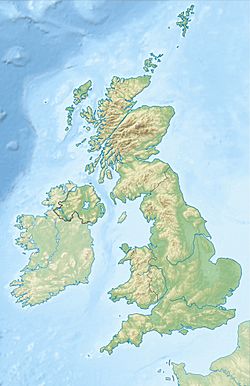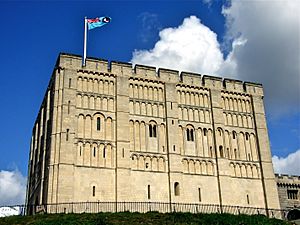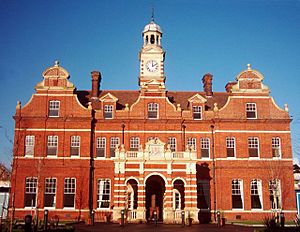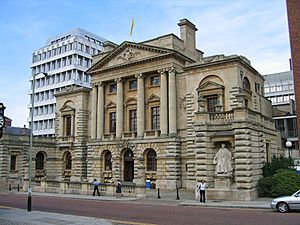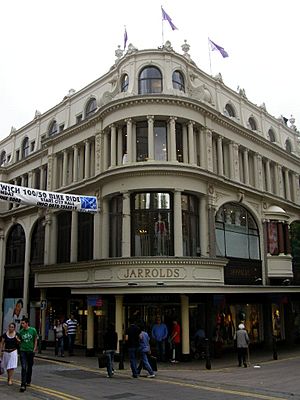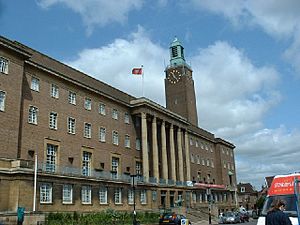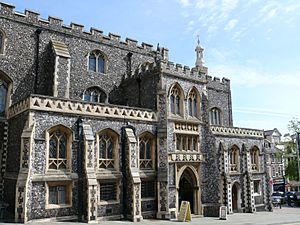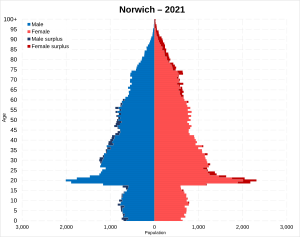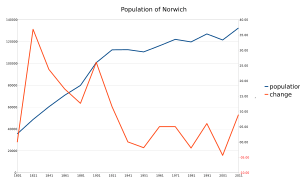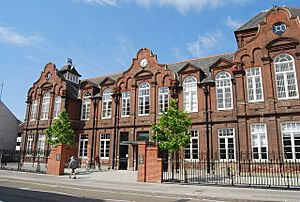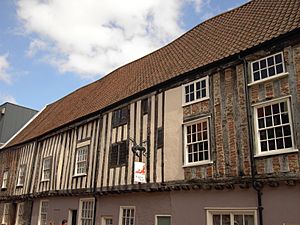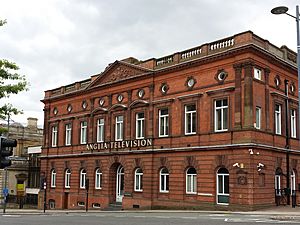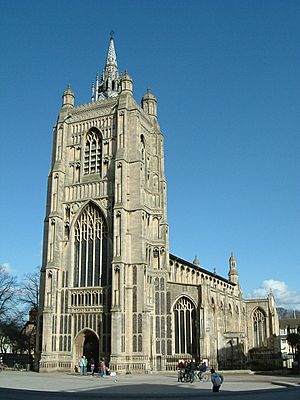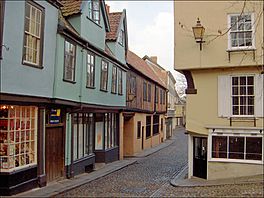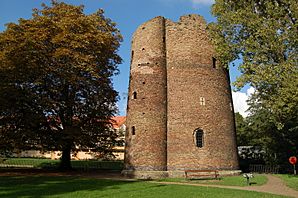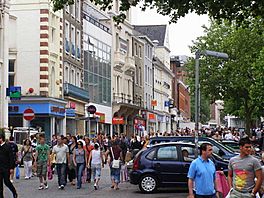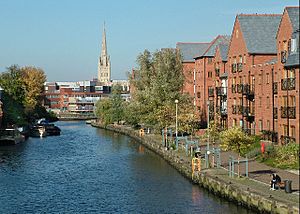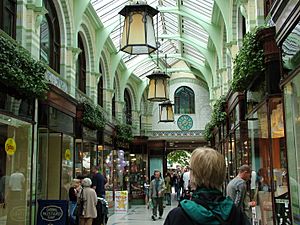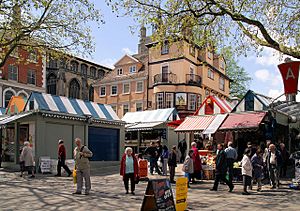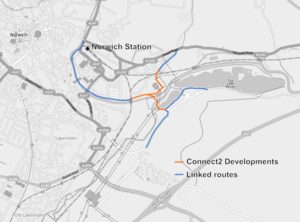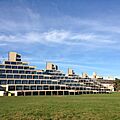Norwich facts for kids
Quick facts for kids
Norwich
|
|||
|---|---|---|---|
|
City and non-metropolitan district
|
|||
| City of Norwich | |||
 |
|||
|
|||
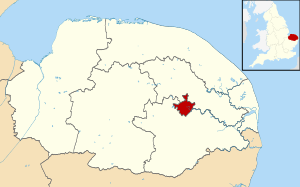
Location within Norfolk
|
|||
| Sovereign state | United Kingdom | ||
| Country | England | ||
| Region | East of England | ||
| County | Norfolk | ||
| Founded | c. 43 AD as Northwic | ||
| City status | 1094 | ||
| Admin HQ | City Hall | ||
| Areas of the city |
List
Bowthorpe
Crown Point Eaton Friars Quay Golden Triangle Heartsease Estate Mile Cross Estate New Costessey (Part) Norwich Lanes Norwich Over the Water Old Catton Riverside Thorpe Hamlet |
||
| Government | |||
| • Type | Non-metropolitan district council | ||
| Area | |||
| • Urban | 20.3 sq mi (52.6 km2) | ||
| Population
(2005 est.)
|
|||
| • City | 140,573 (ranked 157th) | ||
| • Urban | 213,166 | ||
| • Urban density | 10,496/sq mi (4,053/km2) | ||
| • Metro | 376,500 (TTWA) | ||
| Demonym(s) | Norvician | ||
| Ethnicity (2021) | |||
| • Ethnic groups |
List
|
||
| Religion (2021) | |||
| • Religion |
List
53.5% no religion
33.6% Christianity 3.0% Islam 1.2% Hinduism 0.7% Buddhism 0.2% Judaism 0.1% Sikhism 0.9% other 6.8% not stated |
||
| Time zone | UTC+0 (GMT) | ||
| • Summer (DST) | UTC+1 (BST) | ||
| Postcode |
NR
|
||
| Area code (IDD) | 01603 | ||
| Vehicle registration area code | AO, AP, AR, AS, AT, AU | ||
| ONS code | 33UK | ||
| Major railway stations | Norwich Station | ||
| Primary airport | Norwich Airport | ||
| Police | Norfolk Constabulary | ||
| Fire and Rescue | Norfolk Fire and Rescue Service | ||
| Ambulance | East of England | ||
Norwich is a historic cathedral city in Norfolk, England. It's the main town of the county and sits by the River Wensum. Norwich is about 100 mi (160 km) north-east of London. In 2021, about 144,000 people lived in the city area. The larger built-up area had around 213,166 people in 2019.
Norwich is home to one of England's largest medieval cathedrals. For many centuries, from the Middle Ages until just before the Industrial Revolution, Norwich was one of the biggest and richest towns in England. At one point, it was the second largest city after London. Today, it is the biggest city in East Anglia.
Contents
- Discovering Norwich's Rich History
- How Norwich is Governed
- Norwich's Population and People
- Learning and Education in Norwich
- Culture and Fun Things to Do
- Norwich's Buildings and Green Spaces
- Sports in Norwich
- Interesting Facts and Figures
- Economy and How the City Works
- Getting Around Norwich
- Norwich's Location and Weather
- What Travellers Said About Norwich
- Famous People from Norwich
- Norwich's Twin Cities
- Freedom of the City Recipients
- Images for kids
- See also
Discovering Norwich's Rich History
Norwich is known as one of the most complete medieval cities in the UK. You can explore its old cobbled streets like Elm Hill. There are also ancient buildings such as St Andrew's Hall. You can see half-timbered houses like Dragon Hall and Strangers' Hall. The beautiful Art Nouveau style Royal Arcade from 1899 is also a highlight. The winding River Wensum flows right through the city centre.
In 2012, Norwich became England's first UNESCO City of Literature. It's a popular place for tourists. In 2016, The Guardian newspaper called it the "happiest city to work in the UK". The Sunday Times also named Norwich one of the "Best Places To Live" in the UK in 2018, 2019, and 2020.
How Norwich Began
The area near modern Norwich was once home to the Iceni tribe. Their main settlement was close to Caistor St Edmund. After an uprising led by Boudica around 60 CE, the Romans took over. They built their capital for East Anglia, called Venta Icenorum, which means "marketplace of the Iceni". This Roman town was no longer used around 450 CE.
Anglo-Saxons settled where Norwich is today between the 5th and 7th centuries. They founded towns like Northwic ("North Farm"), which is where Norwich gets its name. Norwich grew into an important trading centre in the 10th century.
Early English and Norman Times
It's thought that three small Anglo-Saxon settlements might have grown together to form Norwich. In 1004, Swein Forkbeard, a Viking king, raided and burned the city. But Norwich quickly recovered. Coins from the 8th century show that Norwich was already trading far away.
Between 924 and 939, Norwich became a proper town with its own mint. Coins from this time, during the reign of King Athelstan, even say Norvic. The Vikings had a strong influence on Norwich for about 40 to 50 years. They set up a special area for Anglo-Scandinavians near King Street.
When the Norman Conquest happened, Norwich was one of England's largest cities. The Domesday Book says it had about 25 churches and 5,000 to 10,000 people. It also mentions an Anglo-Saxon church in Tombland, which was the Saxon market place. This is where the later Norman cathedral was built. Norwich continued to be a big trading hub, even called the Port of Norwich.
Norwich Castle was built soon after the Normans arrived. The Domesday Book records that 98 Saxon homes were pulled down to make space for it. The Normans created a new town centre around the Castle. This area became known as the "New" or "French" borough. It had its own market, which is still Norwich Market today. It's the largest permanent undercover market in Europe.
In 1096, Herbert de Losinga, the Bishop of Thetford, started building Norwich Cathedral. The main material for the Cathedral was limestone brought from Caen in Normandy. To get the stone to the site, a canal was dug from the river. The Bishop then moved his main church to Norwich.
Norwich received a special permission from King Henry II in 1158. Another one came from King Richard the Lionheart in 1194. After a riot in 1274, Norwich became the only English city to be excommunicated by the Pope. This means the Pope officially cut off the city from the church.
Medieval Norwich and the Wool Trade
The first record of Jews in Norwich is from 1134. In 1144, a boy named William of Norwich was found dead. The Jews of Norwich were wrongly blamed for his death. William became a saint, and people visited his shrine at the Cathedral. In 1174, Norwich was attacked by the Flemings. In 1190, most Jews in Norwich were killed, except for a few who hid in the castle.
From 1280 to 1340, the city walls were built. These walls, along with the river, enclosed a larger area than the City of London. Building outside the walls was made illegal, which stopped the city from spreading out. Parts of these walls are still standing today.
Norwich became a very important and rich county in England. Its main trade was wool from Norfolk's sheep. The wool trade made England wealthy. Norwich was so important that it was called the fourth most important town in the country. The money from wool helped build many beautiful churches. Norwich still has more medieval churches than almost any other city in Western Europe.
Norwich traded with many parts of Europe, from Scandinavia to Spain. It even had a warehouse for the Hanseatic League, a group of trading cities.
The Early Modern Period: Changes and New Arrivals
The wool industry and religious changes shaped Norwich. In 1549, a rebellion led by Robert Kett took place. Rebels camped outside Norwich and took control of the city. This uprising was against landlords taking land and abusing their power. Kett's Rebellion ended when the rebels were defeated.
Norwich was the first city to make people pay to help the poor. This idea later became the basis for England's Poor Law. Many Dutch and Flemish "Strangers" came to Norwich in the 16th and 17th centuries. They were Protestants escaping persecution. They brought their skills as weavers and helped boost trade with Europe. Their first base in the city is now a museum called Strangers' Hall.
The Norwich Canary bird was first brought to England by these Flemish people. They bred these birds, and the Norwich Canary became a symbol of the city. It's even the emblem of the local football club, Norwich City F.C., known as "The Canaries."
From Civil War to Victorian Times
During the English Civil War, Norwich had supporters on both sides. In 1648, there was a big explosion in the city centre during a riot. This event, called "The Great Blow," caused a lot of damage.
After 1660, Norwich's cloth industry had a golden age. This led to more people living in the city and enjoying things like leisure time and pubs. In the early 18th century, Norwich was a very rich town. It had a good system for helping the poor and many foreign refugees. Despite outbreaks of plague, the city had almost 30,000 people. This made Norwich unique in England.
Britain's first local newspaper, the Norwich Post, started in 1701. By 1726, there were rival newspapers. Norwich had a lively political culture. People could vote more easily than in many other towns.
In 1793, the wool trade faced tough competition and war with France. This caused hardship for many people. In 1795, the Norwich Patriotic Society was founded. They believed everyone should have a say in government.
In 1797, Thomas Bignold started the first Norwich Union Society. He wanted to insure people against fire, which was a big risk in a city built of wood. Norwich Union grew to become a huge insurance company.
Norwich was also famous for making shawls in the 1780s. These were high-quality fashion items. But their popularity declined later, and production stopped.
Norwich was quite isolated. Until 1845, it was often faster to travel to Amsterdam by boat than to London! The railway came to Norwich thanks to Morton Peto.
Norwich in the 20th Century
In the early 1900s, Norwich still had many big factories. They made shoes (like Start-rite), clothes, furniture, and aircraft. Famous companies included Boulton & Paul and Barnards.
Norwich also has a long history with chocolate making. The local company Caley's made chocolate and Christmas crackers. The chocolate factory closed in 1996.
Jarrolds, started in 1810, was a well-known printer and publisher. Today, Jarrolds is famous for being Norwich's only independent department store.
Pubs and Brewing History
Norwich has a long history of brewing beer. Many large breweries operated until the mid-20th century. However, most have now closed. Only small microbreweries remain today.
It's often said that Norwich once had "a pub for every day of the year and a church for every Sunday." In 1870, there were over 780 pubs! By 2018, about 100 pubs were still open in the city centre.
Second World War Bombing
Norwich was heavily bombed during World War II. Many parts of the old city centre and Victorian houses were damaged. The worst raids happened in April 1942. These were part of the Baedeker raids, where targets were chosen for their cultural importance.
Lord Haw-Haw even joked about the new City Hall being destroyed, but it survived. Other important places hit included Morgan's Brewery and the Mackintosh chocolate factory. Shopping areas like St Stephen's St were also damaged.
In these raids, 229 people were killed, and 1,000 were injured. Overall, 340 citizens died from bombing during the war. About 2,000 homes were destroyed, and 27,000 were damaged.
Post-War Changes
After the war, the city council planned a huge redevelopment. While not all plans happened, many areas of Norwich were cleared in the 1960s and 1970s for modern buildings.
Old areas like Richmond, known as "the Village on the Hill," were cleared. Residents had to move to new high-rise buildings or housing estates. A new road, Rouen Road, was built. Many historic buildings were pulled down to make way for new roads and shopping centres like Anglia Square.
Many Georgian and Victorian houses were demolished for road widening. Even some parts of the old city wall were removed. It's been said that more of Norwich's old buildings were destroyed by post-war development than by the war itself.
Other Notable Events
In 1976, Motum Road in Norwich became one of the first roads in Britain to get sleeping policemen (speed bumps). These were put in to slow down traffic.
From 1980 to 1985, Norwich was often in the news because of squatting in Argyle Street. This Victorian street was later demolished in 1986. In 1981, a small tornado hit Norwich, causing minor damage.
How Norwich is Governed
Norwich has two levels of local government: the Norwich City Council and Norfolk County Council. The city council handles things like housing, planning, and tourism. It's based at City Hall. The county council manages schools, transport, and libraries across Norfolk.
City Leaders and Representatives
The ceremonial head of the city is the Lord Mayor. This role is mostly symbolic now, but in the past, the Mayor had a lot of power. The Mayor of Norwich role started in 1403. In 1910, King Edward VII made it a Lord Mayor position.
Norwich also elects two members of Parliament (MPs) to the House of Commons. Since 1950, the city has been split into two areas: Norwich North and Norwich South.
Norwich's Population and People
| Population change | |||||||||||||||||||||||||||||||||||||||||||||||||||||||||||
|---|---|---|---|---|---|---|---|---|---|---|---|---|---|---|---|---|---|---|---|---|---|---|---|---|---|---|---|---|---|---|---|---|---|---|---|---|---|---|---|---|---|---|---|---|---|---|---|---|---|---|---|---|---|---|---|---|---|---|---|
|
|
|
|||||||||||||||||||||||||||||||||||||||||||||||||||||||||
The 2021 United Kingdom census showed that Norwich had about 144,000 residents. This was an 8.7% increase from 2011. The larger urban area of Norwich had 213,166 people in 2011. This area includes suburbs like Costessey and Sprowston. Norwich is one of the most densely populated areas in the East of England.
In 2022, most of Norwich's population was White (87.1%). Other groups included Asian (5.5%), mixed race (3.2%), and Black (2.6%).
When it comes to religion, 33.6% of people are Christian, and 3% are Muslim. A large number, 53.5%, said they had no religion. In past censuses, Norwich was found to be the least religious city in England. The largest age group in Norwich is 20 to 24-year-olds, mainly because of the many university students.
Learning and Education in Norwich
Schools for All Ages
Norwich has 56 primary schools and 13 secondary schools. Many of these are academies or free schools. There are also eight independent schools, including Norwich School and Norwich High School for Girls. For children with learning disabilities, there are five special schools.
Universities and Colleges
Norwich is home to two universities: the University of East Anglia (UEA) and Norwich University of the Arts (NUA). Around 15,000 students attend these universities, many from other countries.
The University of East Anglia, started in 1963, is on the edge of the city. It's famous for its creative writing program. Many well-known writers like Kazuo Ishiguro studied there. UEA also does important work on climate research. Its campus has the Sainsbury Centre for Visual Arts, which holds important art collections.
Norwich University of the Arts began in 1845 as the Norwich School of Design. It was founded by artists to train designers for local industries. It became a university in 2013.
Norwich also has three colleges for further education. City College Norwich is one of the largest in the country.
Culture and Fun Things to Do
Norwich has a long history with art, literature, and publishing. It had England's first local library in 1608. The Norwich Post was the first local newspaper outside London, started in 1701. The Norwich School of artists was the first local art movement in Britain.
Today, Norwich is a hub for publishing. In 2012, 5% of the UK's independent publishing companies were based here. In 2012, Norwich was named England's first UNESCO City of Literature.
Top Attractions in Norwich
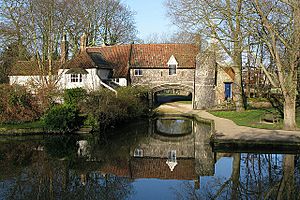
Norwich is a great place for a city break. You can visit Norwich Cathedral, explore the old cobbled streets, and see Norwich Castle. Other attractions include Cow Tower and Dragon Hall.
Norwich is one of the UK's top ten shopping spots. It has a mix of big shops and unique independent stores. Norwich Market is one of the largest outdoor markets in England.
The Forum, opened in 2002, is a modern building. It houses the Norfolk and Norwich Millennium Library, which replaced the old library that burned down. It's also home to the regional headquarters for BBC East. The Forum is a popular place for art shows, concerts, and events.
Norwich promotes its amazing buildings through a group called the "Norwich 12." This includes Norwich Castle, Norwich Cathedral, The Guildhall, and The Forum.
Art and Music Scene
Every year, the Norfolk and Norwich Festival celebrates the arts. It brings many visitors to the city. The Norwich Twenty Group helps promote modern art. Norwich hosted Britain's first arts festival in 1772.
Norwich Arts Centre is a well-known place for live music and theatre. Norwich has a lively music scene with venues like the University of East Anglia LCR and The Waterfront. Many local artists have become famous nationally and internationally.
In 2015, Norwich hosted BBC Radio 1's Big Weekend, a huge music event.
Theatres in Norwich
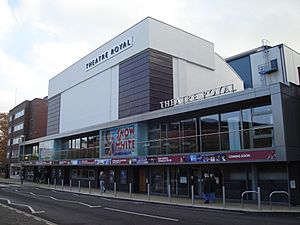
Norwich has many theatres of different sizes. The Theatre Royal is the biggest, with 1,300 seats. It hosts touring shows like musicals, dance, and comedy.
The Maddermarket Theatre opened in 1921. It's designed like an Elizabethan theatre. The Norwich Puppet Theatre is unique in the region, focusing only on puppet shows. Norwich Arts Centre and Norwich Playhouse are other popular venues.
The Whiffler Theatre is an open-air theatre in Norwich Castle Gardens. The Sewell Barn Theatre is the smallest, with only 100 seats.
Museums to Explore
Norwich has several museums that tell the story of the city and Norfolk. The largest is Norwich Castle Museum. It has collections of ancient finds, art, ceramics, and natural history.
The Museum of Norwich at the Bridewell shows what life in Norwich was like from 1900 onwards. It also has exhibits on Norwich's historic industries like weaving and shoemaking.
Strangers' Hall is one of the oldest buildings in Norwich. It's a merchant's house from the 14th century. Its rooms are decorated in styles from different time periods.
The City of Norwich Aviation Museum is near Norwich Airport. It has military and civil aircraft on display. The Norwich Printing Museum shows the history of printing.
Dragon Hall is a medieval merchant's trading hall from around 1430. It's unique in Western Europe.
Entertainment and Media
Norwich has three cinema complexes. Cinema City is an art-house cinema. The city has many pubs, especially on Prince of Wales Road.
Norwich is the home of BBC East, which broadcasts BBC Look East and BBC Radio Norfolk. ITV Anglia, a regional ITV company, is also based in Norwich. It used to make popular shows like Tales of the Unexpected.
Archant publishes two newspapers in Norwich: the Norwich Evening News and the Eastern Daily Press. The famous character Alan Partridge, played by Steve Coogan, is a fictional Norwich broadcaster.
Norwich's Buildings and Green Spaces
Architecture Through Time
Norwich's medieval history is seen in its 11th-century Norwich Cathedral and 12th-century castle. Many of its 57 medieval churches still stand today. It's said that Norwich has more medieval churches than any city north of the Alps. The Adam and Eve is believed to be the city's oldest pub, dating back to 1249.
In the 18th century, architect Thomas Ivory designed several important buildings. The 19th century saw Norwich grow a lot. Architect George Skipper designed famous buildings like the Norwich Union headquarters and the Modern Style (British Art Nouveau style) Royal Arcade. The neo-Gothic Roman Catholic St John the Baptist Cathedral was started in 1882.
The 20th century brought more growth. The City Hall opened in 1938. After World War II, many new homes were built. The University of East Anglia opened in 1964, with buildings designed by famous architects like Denys Lasdun and Norman Foster.
Parks and Gardens
Chapelfield Gardens became Norwich's first public park in 1880. In the early 1900s, Norwich Corporation bought land to create more parks, also helping with unemployment. Heigham Park, Wensum Park, Eaton Park, and Waterloo Park were all built during this time. They still have many of their original features.
As of 2015, Norwich has 23 parks, 95 open spaces, and 59 natural areas managed by the local council. The Plantation Garden is a private garden that opens daily.
Sports in Norwich
The main local football club is Norwich City, also known as the Canaries. They play at Carrow Road Stadium. The club has a strong rivalry with Ipswich Town. Norwich City has played in the top division of English football many times and has won two Football League Cups.
Norwich City Women play in the Women's National League. They won the Women's FA Cup in 1986.
Norwich also has an athletics club, a rugby club, a handball club, and five field hockey clubs. Since 2015, Norwich has hosted an annual 10k running race called Run Norwich.
Outside the city, you can find the Norfolk Ski Club for skiing and snowboarding. Whitlingham Country Park offers outdoor activities like scuba diving and other water sports.
Norwich has two main rowing clubs. The Norwich Canoe Club is very successful in sprint and marathon racing.
In boxing, Norwich has been home to several champions, including Jon Thaxton and Herbie Hide. Norwich also has a UK baseball team, the Norwich Iceni.
Interesting Facts and Figures
Norwich was England's second largest city for centuries before the industrialisation era. This was partly because it was quite isolated and didn't have many raw materials.
In 2006, Norwich was voted the greenest city in the UK. There's also a project to make it a transition town, focusing on local sustainability. Norwich has also been known for its open discussions in public spaces, called "meet in the street," about social and political topics.
In 2007, Norwich won a silver award in the small-city category of the International Awards for Liveable Communities.
Economy and How the City Works
Norwich's economy used to be based on manufacturing, especially shoemaking. But in the 1980s and 1990s, it changed to a service-based economy.
The city's biggest job sectors are business and financial services (31%), public services (26%), and retail (12%). Manufacturing and tourism also provide many jobs.
New developments include the Riverside entertainment complex with nightclubs and other venues. The football stadium is also being improved.
Archant, a national publishing group, started from Norwich's local newspapers and has its main office here.
Norwich is famous for mustard. The world-famous Colman's brand was founded in 1814. Its factory closed in 2019, but Colman's mustard is still made nearby and exported worldwide.
The Norwich Research Park, located south-west of the city, is a hub for research. It includes the Institute of Food Research and the John Innes Centre. The University of East Anglia and the Norfolk and Norwich University Hospital are also part of this park.
Norwich's nightlife, with its bars and clubs, is mainly found in Tombland, Prince of Wales Road, and the Riverside area.
Shopping in Norwich
In 2006, Norwich was the eighth most successful shopping city in the UK. It has an ancient marketplace that started between 1071 and 1074. Today, it's the largest open-air market in England that operates six days a week.
The Castle Quarter is a shopping centre that opened in 1993. It's built mostly underground, with a public park on its roof.
Another shopping centre, Chantry Place (formerly Chapelfield), opened in 2005. It's on the site of an old chocolate factory. It features a large department store, House of Fraser.
A central area of Norwich, known as Norwich Lanes, is famous for its independent shops, restaurants, and cultural attractions. It was named the national winner in the "City" category of the Great British High Street Awards in 2014.
To the north is Anglia Square shopping centre. There are plans to redevelop it with new shops and homes.
Electricity Supply
Norwich first had temporary electric street lighting in 1882. A permanent supply began in 1893 from a power station in Duke Street. This station supplied local businesses and homes. A new power station was built at Thorpe in the late 1920s and operated until 1975.
Getting Around Norwich
Trains and Railway
Norwich railway station is on the east side of the city centre. It's managed by Greater Anglia, which runs most train services.
You can catch frequent trains to London Liverpool Street. There are also hourly services to Cambridge, Great Yarmouth, Lowestoft, and Sheringham.
East Midlands Railway offers direct trains to the Midlands and North West England, including cities like Nottingham and Manchester Piccadilly.
Road Travel
Norwich is connected to Great Yarmouth and King's Lynn by the A47. The A11 links Norwich to Cambridge and the M11 motorway for London. The city also has two ring roads, one inner and one outer.
Norwich has the UK's largest independent car club.
Buses and Coaches
The main bus companies in Norwich are First Eastern Counties, Konectbus, and Sanders Coaches. They serve routes throughout the city and Norfolk.
National Express runs coaches to London and its main airports. Megabus also offers a daily service to London. Most buses leave from Norwich bus station or Castle Meadow.
Norwich has one of the UK's largest park & ride networks, with six sites. This helps people park outside the city and take a bus in. In 2023, the number of passengers using this service increased significantly.
Air Travel
Norwich Airport is a smaller airport that connects to the Dutch airline KLM's hub at Schiphol. Loganair, Ryanair, and TUI Airways also fly from Norwich to various destinations. The airport also serves the offshore oil and gas industry.
Cycling Routes
National Cycle Route 1 passes through Norwich. Norwich City Council also maintains seven colour-coded cycling routes in the city called Pedalways.
Waterways
The River Yare is navigable from the sea up to Trowse, south of Norwich. From there, the River Wensum can be navigated into Norwich. You can take boat trips through the city and out to the nearby Broads. In 2012, Norwich City Council allowed punting on the River Wensum.
Norwich's Location and Weather
Norwich is about 100 miles (160 km) north-east of London. It's 40 miles (64 km) north of Ipswich and 65 miles (105 km) east of Peterborough.
Climate and Weather Patterns
Norwich has a mild, maritime climate, like the rest of the British Isles. It doesn't have extreme temperatures, and rain is spread fairly evenly throughout the year.
Norwich's location in East Anglia, sticking out into the North Sea, can bring unique weather. This includes snow or sleet from northerly winds, or sea fog during summer.
The highest temperature recorded in Norwich was 37.0 °C (98.6 °F) in July 2022. The coldest temperature recorded was −15.3 °C (4.5 °F) in January 1979. Norwich gets a good amount of sunshine, averaging 1558 hours a year. Rainfall is relatively low, around 650 mm (26 in) per year.
| Climate data for Norwich, United Kingdom (1981-2010) | |||||||||||||
|---|---|---|---|---|---|---|---|---|---|---|---|---|---|
| Month | Jan | Feb | Mar | Apr | May | Jun | Jul | Aug | Sep | Oct | Nov | Dec | Year |
| Mean daily maximum °C (°F) | 7.2 (45.0) |
7.4 (45.3) |
10.0 (50.0) |
12.5 (54.5) |
15.8 (60.4) |
18.7 (65.7) |
21.3 (70.3) |
21.4 (70.5) |
18.6 (65.5) |
14.7 (58.5) |
10.4 (50.7) |
7.6 (45.7) |
13.8 (56.8) |
| Daily mean °C (°F) | 4.4 (39.9) |
4.4 (39.9) |
6.5 (43.7) |
8.5 (47.3) |
11.7 (53.1) |
14.5 (58.1) |
16.9 (62.4) |
16.9 (62.4) |
14.5 (58.1) |
11.1 (52.0) |
7.3 (45.1) |
4.8 (40.6) |
10.1 (50.2) |
| Mean daily minimum °C (°F) | 1.5 (34.7) |
1.3 (34.3) |
2.9 (37.2) |
4.5 (40.1) |
7.5 (45.5) |
10.2 (50.4) |
12.4 (54.3) |
12.3 (54.1) |
10.4 (50.7) |
7.5 (45.5) |
4.1 (39.4) |
2.0 (35.6) |
6.4 (43.5) |
| Average rainfall mm (inches) | 56.2 (2.21) |
41.7 (1.64) |
48.7 (1.92) |
44.0 (1.73) |
47.4 (1.87) |
62.2 (2.45) |
55.5 (2.19) |
63.9 (2.52) |
58.9 (2.32) |
68.2 (2.69) |
68.2 (2.69) |
59.3 (2.33) |
674.2 (26.56) |
| Average rainy days | 11.9 | 10.1 | 10.7 | 9.2 | 8.9 | 9.9 | 9.0 | 8.9 | 9.5 | 10.7 | 12.3 | 11.8 | 122.9 |
| Source: WMO | |||||||||||||
What Travellers Said About Norwich
Many famous people have visited Norwich and written about it.
In 1507, the poet John Skelton wrote about two fires in Norwich, saying: "All life is brief, and frail all man's estate. City, farewell: I mourn thy cruel fate."
Thomas Fuller in 1662 described Norwich as: "Either a city in an orchard or an orchard in a city, so equally are houses and trees blended in it."
Celia Fiennes visited in 1698 and said Norwich was "a rich, thriving industrious place full of weaving, knitting and dyeing."
Daniel Defoe wrote in 1724 that people in Norwich were "all busy at their manufactures, dwell in their garrets at their looms."
John Evelyn, a famous diarist, visited in 1671 and noted: "The suburbs are large, the prospect sweet, and other amenities, not omitting the flower-garden, which all the Inhabitants excel in of this City."
In 1775, clergyman James Woodforde called Norwich "the finest City in England by far." He noted its "36 noble Churches" and "a noble River."
George Borrow wrote in his novel Lavengro (1851) that Norwich was: "A fine old city, perhaps the most curious specimen at present extant of the genuine old English Town."
In 1962, Sir Nikolaus Pevsner, a historian, said: "Norwich is distinguished by a prouder sense of civic responsibility than any other town of about the same size in Britain."
Famous People from Norwich
Many notable people have come from Norwich.
Norwich's Twin Cities
Norwich has special "twin city" agreements with four cities around the world:
- Rouen, France (since 1951)
- Koblenz, Germany (since 1978)
- Novi Sad, Serbia (since 1989)
- El Viejo, Nicaragua (since 1996)
Freedom of the City Recipients
The "Freedom of the City" is a special honour given to individuals, military units, and organizations. Here are some who have received it in Norwich:
Individuals
- Ove Fundin
- Colin Self
- Arthur Miller
- Sir Robert and Lady Sainsbury
Military Units
- 1st East Anglian Regiment: 1964
- 1st Battalion The Royal Anglian Regiment: 1984
- RAF Marham: 2008
- 2nd Air Division, USAAF Association
Organisations and Groups
- Anglia TV
- Norwich City Football Club: 2002
- Norfolk Constabulary
- Norwich Union
- The Jarrold Group: June 2020
Images for kids
-
Mousehold Heath, Norwich by Norfolk-based artist John Crome
-
Norwich Arts Centre, opened in 1977, on St Benedict's Street
See also
 In Spanish: Norwich para niños
In Spanish: Norwich para niños





